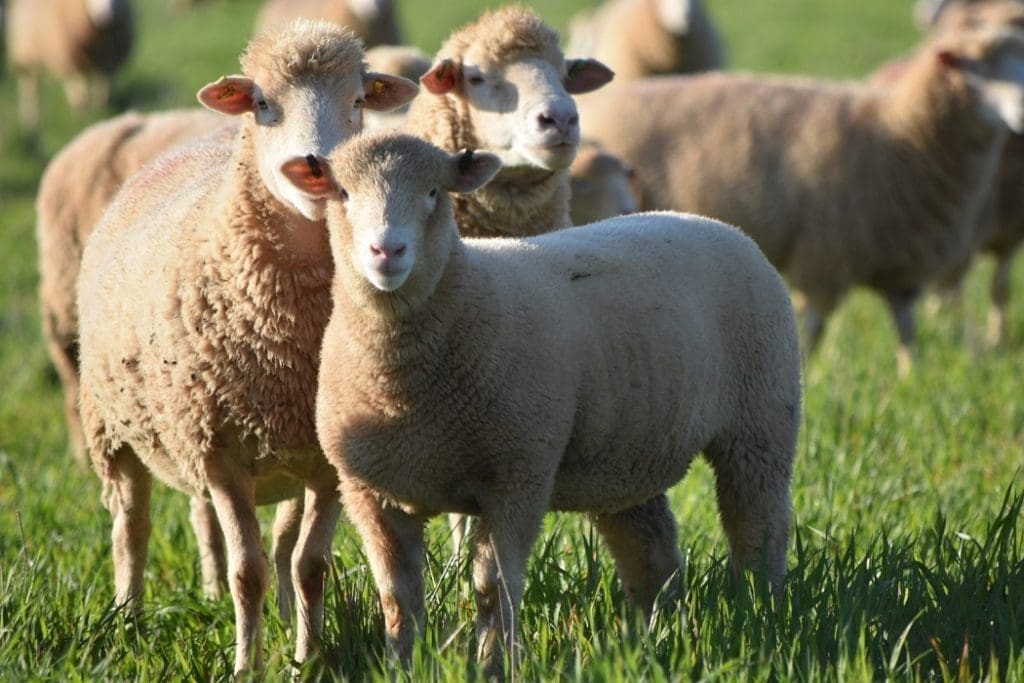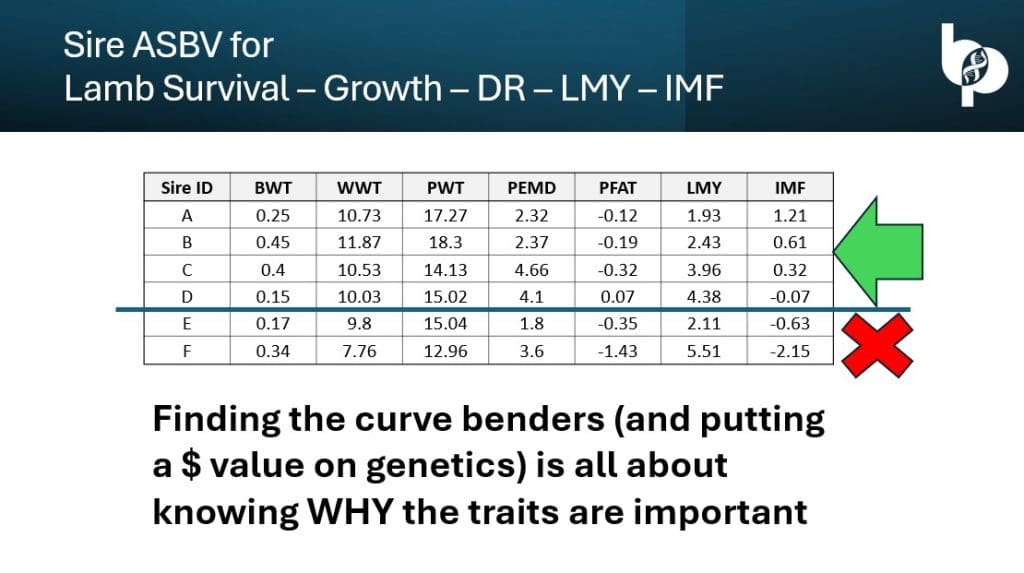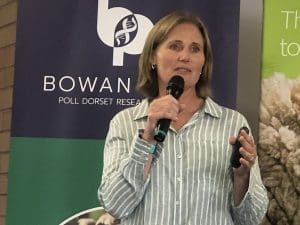
What’s possible: the trial’s ‘pin-up lamb’ that that grew at 471grams/day, with a 54pc dressing percentage at 37/6kg HSCW, 4.81pc IMF and 53.6pc LMY.
A FIVE-YEAR sire evaluation has shown Poll Dorset breeders the breed has potential to produce sires with the genetics to get high eating quality lambs to market sooner and to suit various production systems.
The Bowan Park Poll Dorset Research Flock trial has assessed and benchmarked the production and genetic performance of 73 sires — sires from studs across Australia and with variation from show champions to 1pc Lambplan index rams, that underwent assessment for the survival, growth, carcase weight and dressing percentage, and eating quality of their lambs.
The trial produced 3000 lambs that were marketed in under 19 weeks from 1700 acre property near Cudal in central west New South Wales, owned but run separately by Ridgehaven Poll Dorset Stud.
Only about 20 percent of the sires in the trial came from highly tested populations and the results have indicated potential for faster genetic progress within the breed for high growth good eating quality lamb production.
Presenting results at Gundagai last week, Bowan Park Trial coordinator Isabele Roberts said the trial “is very much an exploration of what we can find rather than this being a finite description of how our breed can perform.”
She said the trial’s lamb carcase results showed that there are Poll Dorset genetics in the industry that will produce lambs that grow fast and have good eating quality – ie. high intramuscular fat – and good eye muscle.

Referring to a table of six example sires, Ms Roberts said there are Poll Dorset sires that have a balance of breeding values that are optimum for lambing ease, maximum for growth and eating quality and eye muscle depth. Ms Roberts said it is hard to get a sire with high ASBVs for muscle and IMF.
“But over time we should be able to find them,” University of New England’s associate professor of meat science Dr Peter McGilchrist said.
“But we are changing physiology so we’ve got to be patient; we’ve just got to slowly find them and breed form them and multiply them.
“We can do it, they’re just rare because it’s not their natural physiology.”
Ms Roberts said assuming good nutrition and management, the trial showed that there is sufficient genetic variation in the Poll Dorset breed to achieve lambs with a high survival and growth rates, good carcase quality and eating quality to match intramuscular fat grids.
She said finding ‘curve bender’ rams – able to give low-medium birth weight lambs with high growth rates – was a critical part of what breeders do.
“We are actively looking for curve-bending rams that do a different job to what the standard ram may.”
Getting marketable lambs faster

Trial coordinator Isabele Roberts
Ms Roberts said days to marketable lamb weight significantly impacts farm production capacity and profitability.
With the goal of a minimum liveweight of 50kg to achieve a 25kg carcase, in the trial’s gestated single/ reared single lamb group, 85pc of the lambs measured over five years achieved 50kg liveweight in 16-19 weeks.
“We had a lamb that could have been sold at 10 weeks of age – he was over 50 kg.
“We had 24 pc of our lambs that could have been sold at 14 weeks over 50kg,” Ms Roberts said.
“We had almost 60pc at 17 weeks and by 19 weeks three quarters of the lambs would be off the farm and gone.
“The trial has reinforced our knowledge of how fast a Poll Dorset lamb can grow. Our winner for average daily weight gain was 521g/day from birth to 19 weeks.”
“Days to marketable weight (or daily weight gain) allows the stocking rate of your farm to actually increase, because the lamb that you are producing – your production unit is gone, and the grass that you grow can be spread over what’s left.”
While recognizing the value of Gundagai Meat Processors IMF lamb grid to the industry and its cooperation in processing trial lambs, Ms Roberts sounded a warning to other lamb processors.
She said the processors had about five years before producers start “talking pretty loudly to make sure that as a lamb industry we are recognized for the quality of the job that we do.”
“Firstly and most importantly, by providing feedback on what we produce and secondly, by paying us for the quality of what we produce.”
She said the meat processing industry, by giving feedback and paying for eating quality, can equip and encourage the industry to make the necessary genetic and production changes.
Ms Roberts said stud breeders need to realise that they can underpin the quality of the lamb to the consumer, and the trial had showed that high growth with the right carcase and eating quality genetics is possible, meaning premium quality lambs can be sold earlier .
Ms Roberts said it has been incredibly rewarding to see that young lambs — 17-19 weeks – can be produced successfully with IMF above 5 percent “when they are under good management and nutrition.”
“It is really quite possible to do as long as you’ve got the right genetics.
“It’s been incredibly valuable for us to see this on-farm, but it’s very possible, you’ve just got to know where your genetics are to do it.”
Putting Poll Dorsets on the eating quality track
Dr McGilchrist said the trial was putting participating Poll Dorset breeders well down the track to producing the lamb consumers will demand in the future.
He showed a graph comparing the breeding value variation within and between breeds on loin eating quality.
“Poll Dorsets, we’ve got a big variation there, right, so some of us have been selecting hard on growth and yield, on things that make you money now, and others had a focus on other traits that have kept their eating quality higher.
“So if there is any breed with bigger variation it’s probably Poll Dorsets,” he said.
“So we’ve got to go harder and select within and use the information we’ve got to get the right ones out going forward.
“But look at the overlap between all those breeds, it’s huge, there is opportunity whichever breed you use – so I’m certainly not breedist.”
Ms Roberts said Poll Dorset breeders had “the best lamb production breed hands down.”
“I think we have explored a lot of genetics to understand what we’ve got to use for the future.
She said Poll Dorset breeders now knew that they had growth and muscle traits with intramuscular fat “and that’s the future of the lamb industry.”
“So when you know what we’ve got you can either discard what doesn’t work or you can expand what does work.
“We are now in a position to do more and do better and do it much faster than we ever would have been before.
“The lamb industry as it sits right now needs a breed that knows where it is going and I feel like that that’s where we are at.”
Dr McGilchrist said variation is valuable. The industry’s Angus benchmarking program is up to its 15 cohort of progeny and has generated more variation in marbling than exists in any other breed in the beef industry, he said.
“And I think that’s what we are probably going to do here in Poll Dorsets.”
He said the Angus program has given animals that suit different production systems and that is the opportunity for the Poll Dorsets.
Dr McGilchrist said last year the Angus breed produced its first marble score 9 animal.
“You can take any trait where you want to go if you’ve got variability.”
Ms Roberts said prime lamb producers need to be able to find rams that suit their production system.
“You have to have variation but you have to know what you’ve got to understand the variation.”
Victorian Poll Dorset breeder Damon Coats said he has had seven rams in the trial and he regards it as “world-leading,” improving his stud’s bottomline and giving it direction to ensure he bred rams that producers wanted.
He said the breed would have been resting on its laurels if the trial had not been initiated and run by Isabele Roberts.
New South Wales breeder Craig Wilson said the trial had brought genetics back to the farm level and he is expecting greater results from the next cohort of trial sires, that includes a bigger variation in highly tested Lambplan measured rams.
Ms Roberts said the trial has also introduced more breeders to objective measurements and ASBVs.
—

HAVE YOUR SAY